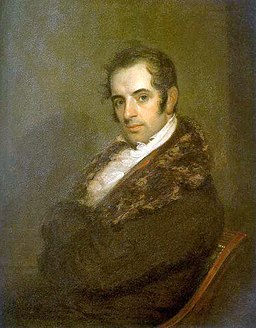One of the many reasons Betsy wanted to live in Europe was to take part in literary society. It’s difficult to imagine this now, but two hundred years ago, there really wasn’t such a thing as American literature.
In contrast, British literature was flourishing.
The Scottish poet Robert Burns had published his poems in 1786. Perhaps the best-known is “To a Mouse,” with this famous stanza:
But Mousie, thou art no thy lane,
In proving foresight may be vain:
The best-laid schemes o’ mice an’ men
Gang aft agley.
An’ lea’e us nought but grief an’ pain,
For promis’d joy!
It’s usually translated into English as follows:
But little Mouse, you are not alone,
In proving foresight may be vain:
The best laid schemes of mice and men
Go often awry,
And leave us nothing but grief and pain,
For promised joy!
Robert Burns, by Alexander Nasmyth, via Wikimedia Commons
In England in 1798, William Wordsworth had published his Lyrical Ballads, and Samuel Taylor Coleridge first published The Rime of the Ancient Mariner, which has these famous verses:
Day after day, day after day,
We stuck, nor breath nor motion;
As idle as a painted ship
Upon a painted ocean.Water, water, every where,
And all the boards did shrink;
Water, water, every where,
Nor any drop to drink.
Gothic novels, such as The Mysteries of Udolpho by Ann Radcliffe (1794) were just beginning to be published. This would become a popular genre in the following decades.
France and Germany, too, had a wealth of literature during that time period.
In contrast, what did the United States have in the way of accomplished writers? Well, during the late 1600s, a couple of Puritans named Anne Bradstreet and Edward Taylor had published beautiful devotional poems. Here is one of the most well-known of Taylor’s stanzas:
Make me, O Lord, thy spinning wheel complete.
Thy Holy Word my distaff make for me.
Make mine affections thy swift flyers neat
And make my soul thy holy spool to be.
My conversation make to be thy reel
And reel the yarn thereon spun of thy wheel.
Although their poetry is still admired today, I doubt that their works had much appeal for Betsy. She was decidedly worldly in her tastes and interests.
Portrait of Washington Irving by John Wesley Jarvis (1809), via Wikimedia Commons
In 1802, Washington Irving began to publish the first of his satirical essays. I can easily imagine Betsy reading and enjoying those. However, there really was not much else for an American with literary interests to take pride in. Irving’s fiction would not appear for nearly two decades, and the works of Hawthorne, Melville, Emerson, and Thoreau would not be published until mid-century.
And perhaps most astonishing to me of all, in my research I discovered that New York City probably had only one theatre!
Once she arrived in Europe, Betsy was able to attend salons where intellectual ideas were discussed and meet famous writers and artist. She even became close friends with a few well-known women writers. I’ll talk about a couple of these later this week.





Interesting. The single theater is most shocking.
I know. Isn’t it unimaginable to think of New York without theaters?
New York without theaters?!
Amazing but true. This country really was a backwater in those days.